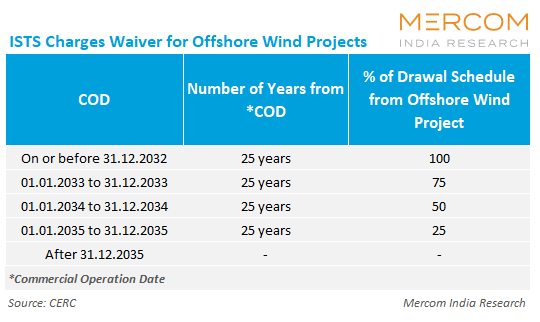No ISTS Charges Waiver for Solar, Wind Projects Commissioned after June 2028
BESS will receive graded waivers, with eligibility phasing out after June 30, 2028
June 27, 2025
Follow Mercom India on WhatsApp for exclusive updates on clean energy news and insights
The Central Electricity Regulatory Commission (CERC) has issued a time frame for waiving interstate transmission (ISTS) charges for renewable energy, energy storage projects, green hydrogen, and green ammonia.
Renewable energy generation stations based on wind, solar, or hybrid sources are eligible for waivers based on their commissioning date. Projects commissioned on or before June 30, 2025, will receive a full waiver for 25 years.
Projects commissioned in successive years up to June 30, 2028, will receive progressively lower waivers, reducing from 75% to 25%. Projects commissioned after June 30, 2028, are not eligible for a waiver.
Energy Storage
The amended provisions also cover energy storage systems (ESS). Pumped storage projects awarded for construction by June 30, 2028, will receive a 25-year waiver.
Battery energy storage systems (BESS) will be treated differently based on their connection and charging source. BESS co-located with renewable power projects at the same substation and charged from such sources are eligible for a 12-year full waiver.
Other BESS will receive graded waivers based on the commissioning date, with eligibility phasing out after June 30, 2028.
The provisions introduce critical flexibility to allow battery systems that are otherwise required to charge from renewables to use grid power in contingency situations. However, the drawal from the grid must not exceed 10% of the battery’s annual energy requirement.
Additionally, BESS paired with co-located renewables, without requiring additional connectivity capacity at the ISTS substation, will still qualify under this beneficial category.
Hydropower
Hydropower projects that sign power purchase agreements (PPAs) or are awarded for construction between December 2022 and June 2028 will receive waivers ranging from 100% to 25% over 18 years. The waiver percentage depends on the PPA signing date or the construction award, whichever is later. Projects beyond June 30, 2028, are not eligible.
Offshore Wind
The waiver for offshore wind projects will apply to systems commissioned up to December 31, 2035, with a declining benefit structure from 100% to 25% depending on the commissioning year. No waivers will apply after December 31, 2035.
Green Hydrogen and Green Ammonia
Green hydrogen and ammonia projects will also benefit as consumers of the ISTS capacity. Projects commissioned up to December 31, 2033, will receive waivers ranging from 100% to 25% for 25 years. The waiver applies to drawal schedules from renewable or hydro generation, or from ESS that meet at least 51% of their annual electricity requirement from renewables. The most favorable source determines the waiver percentage. CERC has provided detailed illustrations to clarify overlapping eligibility scenarios.
Force Majeure-Based Extensions
The amendments include a provision to protect projects facing delays due to uncontrollable factors. Projects originally scheduled to be commissioned by June 2025, including renewable and storage projects eligible for waivers, can still retain their waiver if granted an extension due to force majeure or transmission system delays. These extensions can be granted twice, each for up to six months, and must be approved by relevant authorities depending on the case.
Storage Projects Compliance
To streamline billing, the National Load Despatch Centre (NLDC) will initially accept self-declared compliance with a 51% renewable requirement for storage systems. This will be verified at the end of each financial year. Non-compliance will trigger revised billing without any waiver.
Clarification on Terminal Bay Charges
The amendments also provide clarifications on the responsibility for paying transmission charges when generation projects delay commissioning while the associated terminal bays are already energized. The guarantee of connectivity must bear the cost of such terminal bays, even if generation has not yet started.
The terminology has been refined to consistently refer to both the associated transmission system and terminal bays. Under a new clause, the Transmission System Availability Factor will be calculated per CERC’s Tariff Regulations, regardless of any contrary provisions in transmission service agreements under competitive bidding.
Finally, when yearly transmission charges for certain elements are not approved, the Central Transmission Utility (CTU) will calculate indicative charges based on capital costs to ensure uninterrupted billing.
Revised Charge Apportionment
The amendments also modify the way transmission charges are apportioned within state boundaries. They specify that drawee designated interstate customers, apart from state distribution licensees, will bear a share of the aggregate adjusted charges for unscheduled bay components for the state. The share will be proportional to their general network access.
Rules for Dual-Connected Generating Stations
Generating stations with dual connectivity to both interstate and intrastate transmission systems will now have their transmission deviation computed based on their net metered ex-bus injection. This will be done in time blocks where injection exceeds the combined GNA to the ISTS and the access with the State Transmission Utility (STU). STUs must provide access data to the NLDC and the CTU to enable this calculation.
Subscribe to Mercom’s real-time Regulatory Updates to ensure you don’t miss any critical updates from the renewable industry.





